AI Generated Summary
- US President Donald Trump announced on Wednesday that a trade deal between the two countries is “very close,” raising hopes of a breakthrough.
- But instead of rushing into an agreement, New Delhi has sought to diversify its export markets, particularly in Asia, to reduce its dependence on the US.
- But behind the optimism lies a complex game of economic brinkmanship that has rattled Washington’s allies and exposed the aggressive underpinnings of Trump’s trade strategy.
With just days left before new reciprocal tariffs are set to take effect, high-level negotiations between the United States and India have entered a crucial phase. US President Donald Trump announced on Wednesday that a trade deal between the two countries is “very close,” raising hopes of a breakthrough. But behind the optimism lies a complex game of economic brinkmanship that has rattled Washington’s allies and exposed the aggressive underpinnings of Trump’s trade strategy.
Unlike other nations, India has so far avoided Trump’s infamous tariff letters—bluntly worded warnings sent to over 20 countries, demanding sweeping trade concessions. The letters, which outline steep import duties of up to 50 percent, are not so much invitations to negotiate as ultimatums. Indonesia, for instance, managed to reduce a threatened 32 percent tariff to 19 percent only after agreeing to purchase $15 billion worth of American energy and 50 Boeing aircraft. Japan, South Korea, and Brazil have also been strong-armed, with Brazil hit with a punishing 50 percent tariff in what many analysts call “political grievance diplomacy.”
Trump’s approach has drawn criticism for undermining decades of established trade norms. Unlike traditional negotiations based on mutual concessions, Trump’s tactics rely on unpredictability—using the threat of economic punishment to force countries into compliance. As one trade expert put it, “This is not the art of the deal; it’s the art of the shakedown.”
India’s Calculated Resistance
India’s absence from the list of targeted countries is no accident. Commerce Minister Piyush Goyal and his team have adopted a cautious, calculated approach, engaging in dialogue with Washington without yielding to pressure. India’s pharmaceutical industry—one of the largest suppliers of generic drugs to the US—faces the looming threat of 200 percent tariffs. But instead of rushing into an agreement, New Delhi has sought to diversify its export markets, particularly in Asia, to reduce its dependence on the US.
This strategy has given India leverage. By refusing to bow to Trump’s timelines, New Delhi has signaled that any trade deal must align with India’s economic interests rather than serve as a political trophy for Washington. Analysts suggest that this defiance has earned India respect, even within US trade circles, as a country unwilling to be coerced.
The Broader Impact of Trump’s Tariff Strategy
Trump’s supporters argue that his aggressive tactics are working, pointing to Indonesia’s concessions as proof that high tariffs can push countries to open their markets. But critics warn of long-term consequences: strained alliances, disrupted supply chains, and rising consumer costs worldwide. Many fear that Trump’s approach could trigger a cycle of retaliatory tariffs, further destabilizing global trade.
India’s strategy provides a potential blueprint for other nations grappling with Trump’s economic pressure. By engaging in dialogue but refusing to be rushed, New Delhi has shown that patience and diversification can be powerful tools against coercion.
The Road Ahead
As the August 1 tariff deadline looms, the stakes are high. A well-balanced trade deal between Washington and New Delhi could benefit both economies, particularly in sectors like pharmaceuticals and digital commerce. But such a deal will require genuine negotiation, not public ultimatums.
The world is watching. For Trump, the message is clear: true leadership lies in persuasion, not intimidation. And for nations facing similar pressure, India’s stance serves as a reminder—strategic patience is sometimes the strongest form of resistance.




